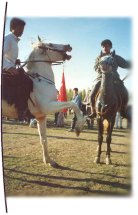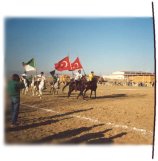Javelin Game
 Jereed, or “çavgan,” is a traditional game which has been played by Turks for many centuries. Turks brought this horse-riding game with them in their journey from Central Asia to Anatolia. For Turks, the horse was both sacred and indispensable. All the days of their lives were spent in the company of horses. Koumiss (kimiz), which means horses’ milk, was their staple drink.
Jereed, or “çavgan,” is a traditional game which has been played by Turks for many centuries. Turks brought this horse-riding game with them in their journey from Central Asia to Anatolia. For Turks, the horse was both sacred and indispensable. All the days of their lives were spent in the company of horses. Koumiss (kimiz), which means horses’ milk, was their staple drink.
For the Turks, jereed was both a great ceremony and a sports competition. Later, in the 16th century, it came to be considered a war game by the Ottoman Turks. In the 19th century, it became the largest sports show and game of the Ottoman state and its palaces. Mahmut II banned jereed in 1826 for its status as a dangerous game. But despite this, the game continued to spread to all the parts of the empire as an important Ottoman war game.
Until 40 or 50 years ago, the game was still widely played across Anatolia, but later its scope shrank to only the areas of Balıkesir, Söğüt, Konya, Kars, Erzurum and Bayburt. And now, for over two decades, the game has retreated across the sands of time into only Konya and Balikesir.
Yet to this day, almost everywhere around the country, young men in villages continue to play jereed on the occasions of weddings and holidays. This sport, along with wrestling, continues to be a contest of bravery in all corners of Türkiye. The zurna, a reed instrument something like an oboe, is played along with drums at the jereed field to grab people’s attention.
The tradition of jereed is still alive in Iran, Afghanistan, Turkmenistan and other Asian countries inhabited by people of Turkish origin.
Today in Türkiye, the game is still played on the second Sunday in September in Söğüt at the Ertuğrul Gazi (veterans’) ceremonies and in Erzurum, Kars and Bayburt to mark various other occasions.
In 1972, a Jereed Festival was organized in Konya by the Konya Tourism Association. Jereed teams from Erzurum and Bayburt participated and gave sterling performances at the festival. There are efforts current underway to restart the jereed tradition in Konya.
In a jereed game, there are two teams. These two teams are placed in rows of 6, 8 or 12 players in a field as much as 70 or 120 meters in length. Jereed players, dressed in regional costumes, mount their horses. With their right hand they hold the first jereed – a long stick – they will throw while holding other jereeds in their left hand. One rider from each side rushes forth towards the opposite side until they are within 30-40 meters of the other side. Then one player shouts the name of a player from the other team, challenging him to enter the game.
He then throws the jereed with his right hand to that player. Later he turns around and he spurs his horse towards his own row. The challenged player from the opposing team follows him and throws a jereed at the player who is running away. Another player from the first row comes out and meets the returning rider. The player from the second row starts riding quickly to his row and takes his former place. This time his rival chases him and throws a jereed at him. The game continues in this manner.
Players who succeed in hitting a player from the opposing team with a jereed win a point, but they lose a point if the jereed hits the horse instead of the player.
 The jereed players can make several different evasive manoeuvres in order to avoid being hit by players from the other team. The rider leans towards either side of the horse, under the horse’s stomach or even its neck. Some players score points by hitting the other team’s player three or four times before that player manages to escape and take his place back in his row. Occasionally players are injured when they are hit on the head, eyes or ears. There are even some cases, albeit rare, where such injuries have resulted in death. A player who dies in the course of a game is considered to have perished in battle, so his surviving relatives don’t seek redress against the other player. Fathers even boast about their sons who lost their lives while taking part in the game.
The jereed players can make several different evasive manoeuvres in order to avoid being hit by players from the other team. The rider leans towards either side of the horse, under the horse’s stomach or even its neck. Some players score points by hitting the other team’s player three or four times before that player manages to escape and take his place back in his row. Occasionally players are injured when they are hit on the head, eyes or ears. There are even some cases, albeit rare, where such injuries have resulted in death. A player who dies in the course of a game is considered to have perished in battle, so his surviving relatives don’t seek redress against the other player. Fathers even boast about their sons who lost their lives while taking part in the game.
Initially, the jereeds were made out of date or oak trees. They measured 70-100 centimetres long and were 2-3 centimetres wide. Later, in order to minimize the risk of fatalities during play, wood from poplar trees came into favour in making jereeds. The two ends of the sticks were cut into a cylindrical shape and made round. The wood’s bark is also removed so as not to injure the person it hits.
The game’s spectators yell and shout in order to encourage the players and their horses.
If two relatives are playing in a game, they are not placed on rival teams, but on the same one. Young men have to respect this decision of the older men, and the older men respect this tradition. At the end of a jereed game, a council formed by former jereed players decide which team will be named the winner. The organizers of the game host dinners and hands out awards to the victors.
The game of jereed was first introduced to Anatolia by Alpaslan, and later it spread to European and Arab countries. In the 17th century, the game started to be played in France, Germany and other countries on the continent.
The Konya Tourism Association once again put this national battle game into the spotlight by organizing a Jereed Festival in September of 1972.
Here are some terms used in the game of jereed:
Değnek, diğnek, deynek: Other names for jereed in certain regions.
Cirit havası: Sections or the entirety of the music played during the game on the drums and zurna.
At oyunu (Game of the Horse): What jereed is called in the areas of Tunceli and Mus.
At oynatma havası: Before the jereed game begins, this is a special music with a particular rhythm played to make the horses trot and dance.
Rahvan: This is a special gait of the horse when the horse moves the two feet on either side of its body in unison, as if running with two feet. This way, it doesn’t shake the rider.
Tırısa kalkmak: The name for a running style in which the horse moves the two feet on opposite, diagonal sides of the body in unison. This is a fast gait which shakes the rider.
Dörtnal (Four horseshoes): The fastest running speed of the horse.
Hücum dörtnal (Four horseshoes attack): Riding a horse at full speed towards a target.
Adeta: The regular gait of a walking horse.
Aheste: When the horse walks slowly, putting weight on his hips.
At başı (horse’s head): Used to describe two horses running nearly even, or neck-and-neck.
At cambazı (horse daredevil): A player who makes a great show of riding skills on the horse.
At oynatmak: Showing your skills with jereed.
Sipahi, sipah, ispahi: This was the name given to a group of horse-riding soldiers in the Janissaries. Good jereed players or good horse riders are also given this nickname in some areas.
Seymen olmak: Wearing local costumes at a wedding in Ankara or the surrounding area.
Osmanli (Ottoman): Horse rider, cavalryman.
Menzil: During jereed, players who are lined up on their horses.
Alan (field): Jeered playing field.
Şehit (martyr): The name given to players who are killed during the game.
Acemi (rookie, someone who new to a profession, someone lacking skill): A player is called an acemi if the jereed he throws hits the horse rather than the player of the opposing team.